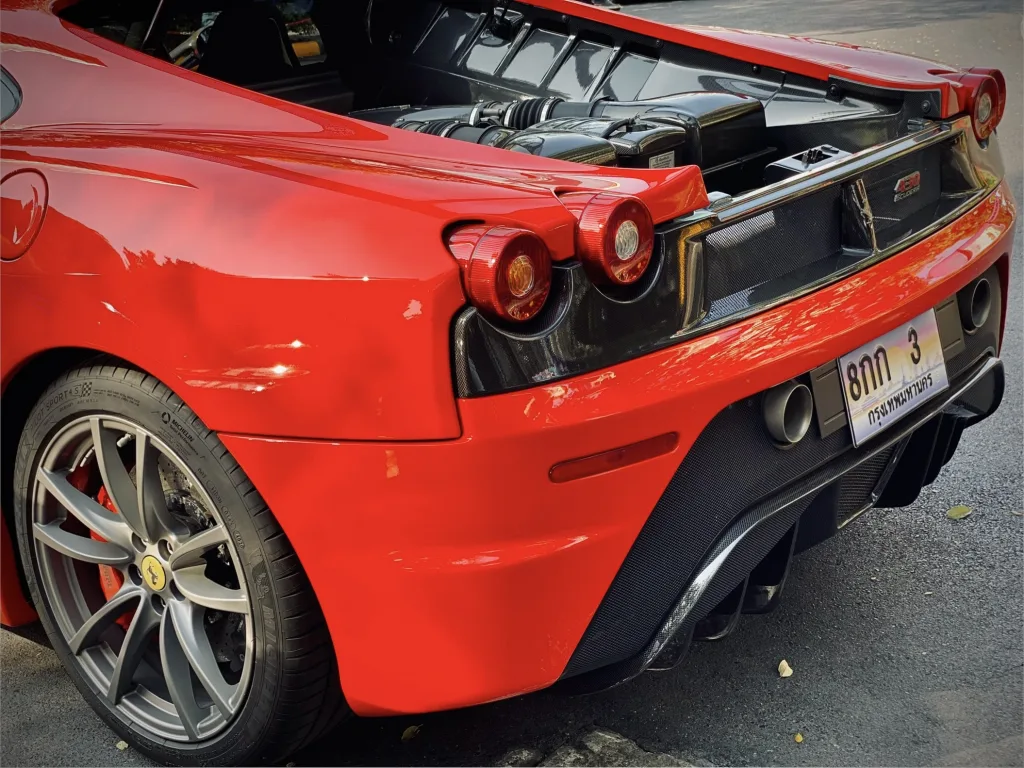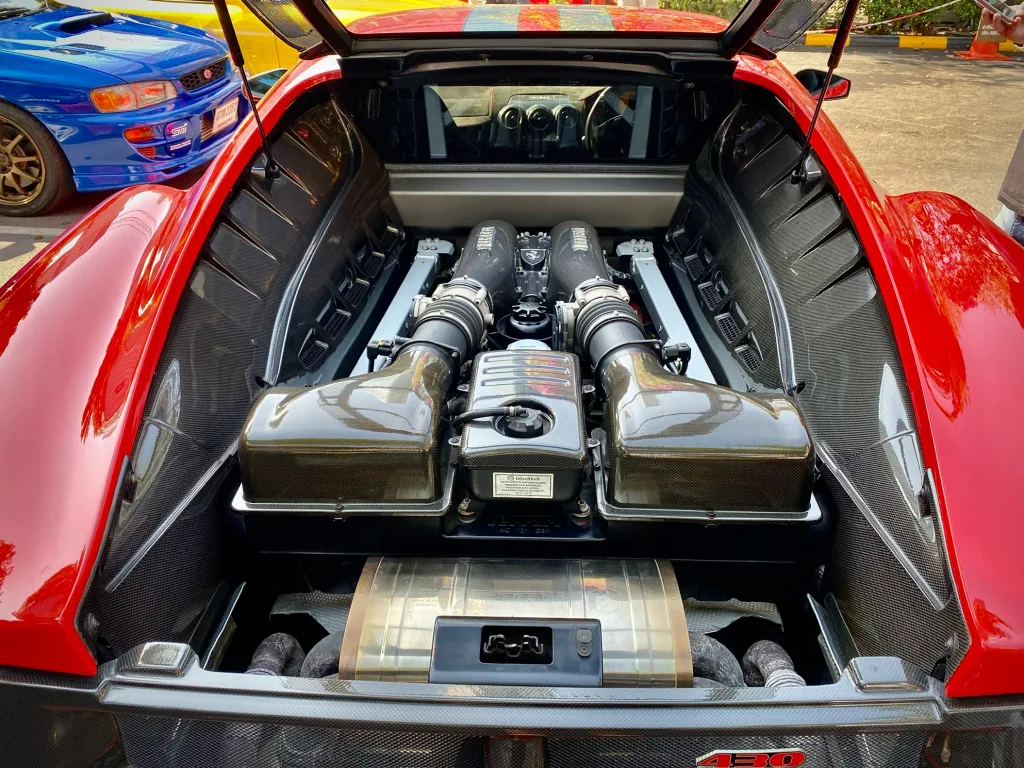Karkrub Review
The Ferrari F430 Scuderia is an automobile that connoisseurs of speed and engineering marvel at. Unveiled by the revered Italian manufacturer Ferrari, the F430 Scuderia is a machine that distills racing pedigree into a street-legal supercar.

Specs of the Car:
At the heart of the Scuderia is a 4.3-liter V8 engine that churns out 503 horsepower, an impressive bump from the standard F430’s 483 hp. It clocks 0 to 60 mph in a mere 3.6 seconds, storming onwards to a top speed of around 198 mph. The Scuderia shaves off weight compared to the base model, tipping the scales at 2,977 pounds, thanks to extensive use of carbon fiber and a stripped-back interior.

The History of the Model:
The F430 marked the evolution of Ferrari’s mid-engine V8 lineage, succeeding the 360 Modena. The Scuderia was introduced in 2007 as a tribute to Ferrari’s racing division and to celebrate the company’s 16th Formula 1 Constructors’ Championship.

The Development of the Model:
The F430 Scuderia was developed with direct input from Michael Schumacher, Ferrari’s F1 driver at the time. His influence is evident in the F1-Trac traction control system and the E-Diff2, which were adapted from the F1 car to improve the car’s handling and agility.
Journalist Reviews at the Time of Release:
Upon its release, the F430 Scuderia received acclaim from automotive journalists for its blistering performance and track-focused nature. It was often praised for its communicative steering, precise handling, and the raw, engaging driving experience it offered.
Types of Modifications Typically Done:
Owners of the Scuderia often opt for modifications such as aftermarket exhaust systems to further enhance the already thunderous sound of the V8. Performance tuning, ECU upgrades, and cosmetic enhancements like custom wraps or new wheel sets are also common.
Karkrub Score
Design:
The F430 Scuderia’s design is a masterful blend of form and function, featuring aerodynamic lines that serve both aesthetic and performance purposes. The aggressive stance and race-inspired details score it a solid 9/10.
Power:
With its tuned V8 and lightning-fast gear shifts, the Scuderia is a powerhouse. It’s an exhilarating drive that’s hard to match, deserving a 9.5/10 for sheer thrill.
Fun:
This car is about the joy of driving. Every element is crafted to engage and excite, making it a perfect 10/10 on the fun scale.
Comfort:
Comfort takes a backseat in this performance-oriented vehicle. Sparse amenities and a firm ride mean it scores lower, at 6/10.
Reliability:
Ferraris are known for their craftsmanship, but the high-strung nature of performance cars like the Scuderia can lead to more frequent maintenance. It scores a 7/10 for reliability.
Safety:
The Scuderia comes equipped with top-tier safety features for its time, but it’s a high-powered sports car with no compromise on speed, which can be a double-edged sword. It gets an 8/10 for safety.
Value:
While expensive, the Scuderia holds its value for collectors and enthusiasts, due to its limited production and iconic status. Its value rating is a strong 8/10.
Average Score: 8.2/10
The interior of the Ferrari F430 Scuderia is a testament to its focus on performance and driver engagement. Ferrari has stripped down the interior compared to the standard F430 to save weight and enhance the car’s racing pedigree. Here are the key features of the Scuderia’s interior:

- Racing Seats: The Scuderia is fitted with carbon fiber racing seats that are lighter than the standard seats. They provide enhanced support and rigidity, crucial for maintaining driver stability and comfort at high speeds and during aggressive maneuvers. The upholstery is typically a high-grip cloth or Alcantara to keep occupants firmly in place.
- Sparse Amenities: To save weight and emphasize its track-focused nature, the Scuderia’s interior is devoid of some of the luxury features found in the standard F430. You won’t find thick carpeting or extensive sound-deadening materials. This not only reduces weight but also allows the driver to be more in tune with the car, experiencing every sound and vibration.
- Alcantara and Carbon Fiber: The interior is swathed in Alcantara and carbon fiber. The dashboard, door panels, and center console all feature this lightweight, high-quality material, giving the cabin a race-inspired look and feel. The use of carbon fiber is not just aesthetic; it significantly reduces the interior’s weight.
- Instrument Cluster and Steering Wheel: The instrument cluster is designed with clarity and performance in mind. A large, central tachometer dominates the view, flanked by essential gauges and a digital display that provides the driver with real-time information. The steering wheel is inspired by Ferrari’s Formula 1 cars and includes the “manettino” dial, allowing the driver to adjust vehicle settings such as traction control and suspension on the fly.
- Air Conditioning and Audio System: While many track-focused cars eliminate air conditioning and audio systems for weight savings, the F430 Scuderia offers these as options. However, they are far simpler systems than those found in the standard F430, emphasizing the car’s no-frills, performance-oriented nature.
- Door Panels and Handles: In keeping with the lightweight theme, the door panels are simplified, and traditional handles are replaced with fabric pull straps. This is a common feature in racing cars and further emphasizes the Scuderia’s focus on weight reduction and speed.

Karkrub Story
The interior of the Ferrari F430 Scuderia is a blend of luxury, technology, and minimalism. It provides an immersive and raw driving experience, ensuring that the driver is connected to the car and the road in a way that few other vehicles can offer. Every element is designed to enhance performance and convey the sense of being in a true race car, yet it remains just refined enough to be enjoyed on the road.
On a Sunday morning, as the city of Bangkok awakened to the gentle caress of the early sun, something extraordinary was unfolding in a quiet parking lot. It was on this day that the Car and Kopee group—a collective of car enthusiasts and dawn risers—had planned their much-anticipated meetup. The air was fresh, and there was a sense of tranquility, a rare feeling in the usually bustling city.

As the members of the group began to arrive, the silence was gradually replaced by the symphony of engines coming to life. Among the eclectic mix of classic sedans, modern sports cars, and customized rides, there was an air of expectation for something truly spectacular to make an appearance.
Then it happened. Rolling in with a confident purr that crescendoed into a visceral roar, the Ferrari F430 Scuderia made its entrance. It was a sight to behold—the iconic Rosso Corsa paintwork seemed to capture the soft morning light, turning the car into a fiery specter against the concrete backdrop.
Heads turned and smartphones were whipped out as the Scuderia took its place among the other vehicles. It was more than just its appearance that captivated the crowd; it was the aura of the car, a presence that filled the space around it. The Scuderia was not just a car; it was the embodiment of a legacy, a masterpiece of engineering that bridged the gap between art and speed.
The crowd gathered around, and the owner, with a mixture of pride and humility, popped the hood to reveal the heart of the beast—a gleaming V8 engine. The group was enthralled by the tales of its track days, the meticulous care that went into its maintenance, and the sheer joy it brought on open roads.
As the morning wore on, the Car and Kopee group shared coffee and conversations, with the Ferrari F430 Scuderia at the center of it all. It wasn’t just the specs and the performance that they admired, but the passion that the Scuderia represented—a passion for the craft of automobile making, for the history of the prancing horse, and for the pursuit of driving excellence.
In the calm of that Sunday morning, amidst the camaraderie of fellow car lovers, the Ferrari F430 Scuderia wasn’t just spotted; it was celebrated. It was a reminder that in the world of automobiles, there are cars, and then there are legends—and the Scuderia was, undoubtedly, the latter.

Leave a Reply